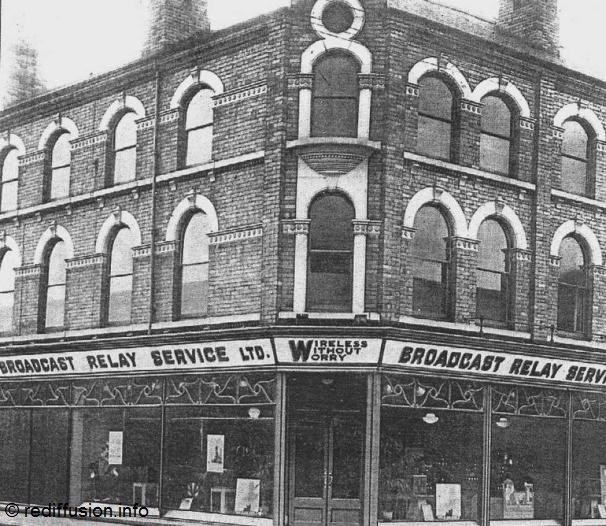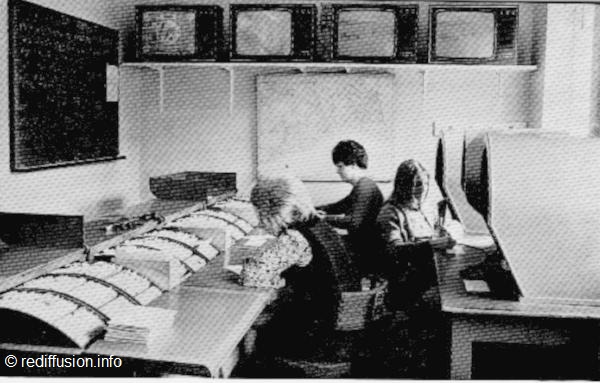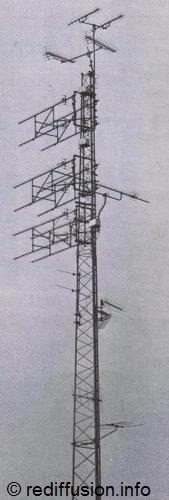
Background
The Yorkshire Region had its origin in the first concession to be granted, in 1929, to Broadcast Relay Services Limited; this permitted operations in the City of Kingston-upon-Hull, which is the full title by which the town known commonly as 'Hull' is correctly dignified, and in the village of Cottingham. The single programme system was soon developed to cater for two programmes and it continued in this form until the years immediately following the War. In 1948, four-programme conversion started in earnest throughout Kingston- upon-Hull and at the same time in the villages of Hessle, Anlaby and Willerby, to the west of Hull, which had been recently added to the area.
During 1951, Beverley Relay Service was taken over and the same year saw the commencement of wired vision. in TDUK.1 form. feeding a large estate in North Hull. The TDUK.1 system was changed to TDUK.2 in 1956 and considerably extended, use being made of the Winter Hill
(Lancashire) transmitter via a microwave link to provide a second vision programme, otherwise not receiveble in the area. As the networks comprised one quad and one squad at this time, it was necessary to resort to phantom methods to distribute the required number of sound programmes, a situation which continued until 1960 when 'physicalization‘ of the entire feeder systems was put in hand.
A significant expansion of the Regions activities resulted in 1960/1961 from the addition of two towns to the operational ambit. These were
Grimsby, on the Humber‘s southern shores, and Hornsea, a delightful East Riding holiday resort.
The Grimsby enterprise was something of a tour de force in the face of considerable competition from an established v.h.f. system which
enjoyed the advantage of Council support.
Notwithstanding these obstacles, rapid progress was made in developing the Rediffusion h.f. system.
In Hornsea, as with Beverley. a two-programme audio network was quickly redeveloped into a TDUK.2 system.
At this point in time all VTR / HLL circuits were `in the air' in the form of two squads, and it was patently obvious that better crossview
protection coupled with improved performance in other directions would be necessary for the distribution ot 625-line standards. Bearing in mind that the longest trunk route in Kingston-upon-Hull extends for some 10 miles and that the network henceforth was to comprise four coaxials plus four quads, it will be evident why the alternative of underground distribution had to be adopted.
The B.B.C. began to radiate the first u.h.f. programme for Yorkshire from Emley Moor on Channel 51 during the Winter of 1965 and by
using extremely efficient aerials and amplification equipment it was possible to provide a service to subscribers which was not viewable off-air
in Kingston-upon-Hull, Hornsea, Beverley and Grimsby. Coincident with the formidable task of up-dating the networks for 625-line working, the
job of modifying some 30,000 single-standard receivers went ahead.
The mid-sixties saw a further expansion of the Yorkshire Region in the form of numerous retail and rental outlets in Leeds, Harrogate, Hudders-
field, Wakefield, Bradford and Halifax, and in 1968 came the acquisition of an h.f. and a v.h.f. System from the Top Rank Organisation in Keighley and Shipley. Steps were taken almost immediately to replace the v.h.f. system in Shipley by h.f.
Consequent on the rearrangement of Regional boundaries, Rotherham Rediffusion Service, having some 13,600 wired vision subscribers and formerly part of the East Midlands Region, was transferred to the Yorkshire Region in 1969.
Further v.h.f. systems situated in the Calder Valley at Todmorden, Hebden Bridge, Ripponden, Mytholmroyd and Luddenden were absorbed during 1969. These systems had been modernised to cater for colour programme distribution.
Engineering staff who had played a significant role in the development of the system over many years included such personalities as;
R. V. Roscoe, M. Exwood, F.l.E.R.E., T. A. Cross, F.l.E.R.E., C. J. Towers, B.Eng., C Eng., M_l.E.E. and F. Hague, F.S.R.E.
The Regional Engineering Organization
After fifteen years' service in the Royal Navy Mr. F. Hague. the Chief Engineer, joined the Company at the Wallasey Branch in 1945: later in
the same year he was appointed Chief Engineer of Rediffusion (Malta) Limited and he remained for nine years in the George Cross island. In1955 he returned to the U.K. and became Liaison Officer with Rediffusion Research Limited.
The Assistant Chief Engineer was Mr. L. Brown who started his Rediffusion career at Rotherham in 1936 as Operator and Equipment
Engineer. He transferred to Hull in 1946 to plan the reorganisation of networks following extensive damage by enemy action during the War and took responsibility for all networks and, |ater equipment, eventually being promoted to E i C of Hull Branch. He was appointed Head of the Test Department in 1968 and Assistant Chief Engineer (Technical) in April 1970.
His counterpart in the post of Assistant Chief Engineer (administration) was Mr.A.H.Tweedale. Following service in the RAF. he joined the
Company as an Equipment Engineer in 1947 and transferred to the Television Department in 1952. later being made E-i-C (Television). Following a brief secondment to the West Indies in 1953 as E-i-C (TV) for Rediffusion (Trinidad) Ltd., he returned to Hull and shortly afterwards was appointed Assistant to the Chief Engineer. He became Assistant Chief Engineer (adrninistration) in 1968 with responsibilities for many aspects of engineering organisation in the Region.
The Regional Test Department comprised four engineers: they were:
Mr. J. Sole, responsible for the final testing after installation of all aerial site equipment and the routine maintenance of it thereafter.
Mr. J. E. Moody. Concerned with audio equipment, frequency response. linearity, pulse-and·bar and equalization testing of hf. networks.
Mr. A.Sherer vvho also conducted the same range of tests on both h.f. and v.h.f. networks. He worked in collaboration with branch engineers on feeders which had complex irregularities to be ironed out.
Mr. M. Beardshaw. whose responsibility was the design and maintenance of control, monitoring and telephone systems.
A Training School was established to supplement the Central Training School facilities, with Mr. J. W. Curwood holding the joint appointments of Regional Training Officer and Regional Transport Officer. The school premises were equipped to provide instruction ranging from network maintenance to colour receiver servicing.
The Regional Planning Office was in the charge of Mr. R. Wainwright, who, with his staff, was responsible for the planning of all systems,
h.f., v.h.f. and communal aerial, throughout the Region.
The day-to-day planning of feeders in branches was carried out locally, subject to the approval of the Regional Office.
Other Regional departments included the Regional Stores, under the able supervision of Mr. H. Adams (Regional Stock Controller) and the
Storekeeper, Mr. D. Tutty, and the Regional TV Refurbishing Department, including a well equipped polishing section.
Branch Organisation
The Hull Branch, by the the largest ln the Region, comprised the hf. distribution systems in Hull, Beverley and Homsea and was under the
control of an E-i-C (Network), Mr. K. Allott, and an E-i-C (Equipment), Mr. M. Butler.
The subscriber figure of 46,200 gives a density of 43% of all houses live for vision. The networks included most of the possible cable combinations, namely one quad + two squad, 2q r 2sq, 2q + 4-pair, 1q + 1sq + 4-pair, 1q + 6·pair and 9-pair. The system used in Hull, Beverley and Hornsea was TD.84.
Facilities were available in the Central Control room to select various transmissions remotely at the receiving station. The photograph shows the complexity of the arrays which enabled the branch to receive signals from Emley Moor (West Riding), Belmont (Lincs), Bilsdale (North- Riding) and Waltham (leicestershire) transmitters. This had proved advantageous during periods of abnormal propagation. Co-channel
interference had been apparent on the Belmont and Emley Moor transmissions at certain times of the year and it was found that during these periods of exceptional conditions, signals from the more distant transmitters of Bilsdale and Waltham gave very acceptable pictures which
could he substituted for the channels normally used.
The HLL / VTR trunk routes totalled some 68km and feeder network 1,677km.
In charge of all television and network maintenance was the Service Manager, Mr. J. Gill. Thirty field service television technicians and ten
network technicians attended to fault complaints, whilst a workshop staff of twenty senior technicians and apprentices dealt with major
receiver faults on the bench. Thirty vehicles were employed on field maintenance and twelve of them, principally the network vans, were equipped with v.h.f. R/T.
Schools Broadcast
The Hull Branch played a major role in developing closed-circuit television services in many colleges and schools. This began in 1954
when several Teacher Training Colleges throughout the country undertook to carry out experiments in using closed-circuit television as a teaching aid. At Hull an original approach gave rise to a system which, in addition to being suited to the main aim, was fiexible in operation.
The Hull College of Education started from the pedagogic rather than the technological end of the problem and instead of accepting the
common assumptions about what was technically possible and shaping the educational procedures accordingly, the College first decided what was educationally desirable and then asked that the technical problems be tackled. They felt that the scheme should preserve the 'natural' setting for transmitted material, wherever possible, and this presented a challenge to conventional ideas about CCTV.
The system designed by the Hull staff provided for programmes to be transmitted live from a total of some 30 points in laboratories, lecture rooms, craft rooms and the principaI's study and for these programmes to be viewed simultaneously in any of the same locations on a standard Rediffusion hf. receiver, on which three off-air programmes could also be received, via the network. Talk·back facilities were provided to allow participating classes to ask questions of the lecturer, so removing the fear that CCTV might encourage mere passive absorption by the students.
It was decided that the best way of meeting these requirements was to use a single squad cable forming as nearly as possible a loop system
and, where bifurcations had to be made, to use a 6dB resistive splitter arrangement so that the contribution circuit could accept pictures from
either direction. In order to obviate the necessity for jacking out sections of the contribution squad cable when the camera output was injected into the loop, the very simple method of direct bridging of the line with half the line impedance was adopted.
The loop was broken at one point and terminated at one end, the other end being repeatered and fed back into the h.f. distribution circuit
together with the off-air programmes. After the original installation was carried out, the system was further extended and improvements, such as the fitting of a G.539 Carrier Regeneration Unit to provide better carrier frequency relationships were made.
Rediffusion also played an interesting part in another aspect of educational television in Hull. The Hull Education Department inaugurated, in
1969, a Schools' Television Service and Rediffusion provided facilities for the distribution of this schooIs' programme to about 220 schools
and colleges which had the Rediffusion h.f. system installed
A studio complex was designed and constructed on a site which gave easy cable access to the receiving station that fed the large Hull system,
and the studio was fitted out by Rediffusion Industrial Services Ltd.
The Education Department were permitted to use the BBC.2 circuit for the Schools Service at times when trade test transmissions were being broadcast. As subscribers would have been able to switch to the schools' vision and sound, they had to deny them this privilege by phantoming the sound. The schools were given the means for extraction and recombination with the vision by the use of accurately matched resistors and a P.119 audio blocking insert in the programme switch.
The remote receiving station switching facilities at Central Control were used for switching the schools' programme to the circuit concerned
Rotherham
The second largest branch was Rotherham, where some 13,600 subscribers provided a density of 23% from a VTR / HLL and feeder network
totalling some 53km and 639km respectively. There were distribution points at Rotherham, Mexborough, Wickersley and Wombwell and the
system was TD.83 in all areas. The feeder network was made up of a mixture of 1q + 1sq +4-pair, 9-pair and 1q + 2sq, whilst the VTR / HLL's
were both squad and coaxial. Various community service schemes covered a total of 1.200 revenue producing dwellings.
The E-i-C of the Rotherham area was Mr. S. Carmichael whose career with the Company began in 1951 as an Operator, progressing to
Equipment Engineer and Senior Equipment Engineer. In 1990 he was appointed E-i-C at Grimsby and was responsible for the engineering
development of that branch from its foundation. He moved to the post of E-i-C, Rotherham, early in 1970, at the critical period of the conversion
to 625 line standards.
Grimsby
The E-i-C. Mr. L. Rice, served in the branch from 1960, successively as TV Service Technician, TV Supervisor and Senior Equipment Engineer, until his appointment to the most senior position in 1970.
Although the enterprise was begun without support from the Town Council and in the face of established v.h.f. relay competition, it achieved
a total of some 5,000 subscribers, representing a density of 32% of houses touched, on a network of 174km. The system employed is TD.84, with inputs received from the Belmont and Emley Moor transmitters.
Shipley, including Keighley
When taken over from the Top Rank Organisation in 1968, Keighley had a 9-pair h.f. Network but Shipley was operating with a narrow-band
v.h.f. system. Mr. D. Carrick, the E-i-C, joined the Hull branch in 1955 and gained successive promotions in the test and Equipment engineering departments until 1968, when he received the Shipley appointment. His efforts contributed to the doubling of subscribers following the take-over date. His responsibilities included the replacement of the v.h.f. system at Shipley by a 9-pair system operating on TD.84/2. The subscriber densities in the Shipley and Keighley areas of 60% and 50% respectively, reflected the popularity of the service in the towns. The signals for both services were received from the Emley Moor and Winter Hill transmitters, the aerial site for Keighley being situated on the well known Ilkley Moor.
The original Rank aerial site was at the highest point of Ilkley Moor and a v.h.f. link some 5000 yards long and containing twelve repeaters
was used to bring the inputs to the Central Control. Because of operational difficulties and interruptions resulting from lightning, not infrequent
on the moors, a new aerial site was established in a more accessible position on the fringe of the moor, thus shortening the link which was also
converted to h.f. operation.
Calder Valley
In 1959 Rediffusion acquired interests in General Piped Television, the operations consisting of a number of small towns close to the Lancashire border. These were Todmorden, Hebden Bridge, Ripponden, Mytholmroyd and Luddenden.
The systems were originally designed for narrow band operation and they were updated to wideband working under the able direction of
Mr. J. Sunderland, the E-i-C.
The subscriber figure stood at 5,300 with a density ot 80% on a network which provided, in the main, four 625-line and two 405-line pictures from Emley Moor, Winter Hill and Holme Moss.
The Todmorden network was the largest in the Calder Valley, having 30 repeaters in tandem on the longest trunk. Automatic level and slope
compensating units were fitted to compensate for level changes due to variations in temperature and electricity supply voltages.

REDIFFUSION (Yorkshire) LIMITED
Rediffusion House, 151/159 Beverley Road
Kingston-upon-Hull, Yorks HU3 1UA Tel. 0482 28691
Associated Companies in over 175 towns in Great Britain and in Barbados, Bermuda. Canada, Ceylon, Guyana,
Hong Kong, Jamaica, Malaya, Malta, Singapore, South Africa, Trinidad and West Africa etc.
© rediffusion.info 2010
A look back at the foundation of the Yorkshire Region based around activities in the early - 1970's.
 |
Receiving Aerials at Hull |
|
 |
Regional Training School |
|
 |
Control Desk Schools Television |
|
 |
Broadcast Relay Building Hull c1930's |
|
 |
Yorkshire Regional Map |
|
Click thumbnails for a larger image.
Regional Headquarters at Beverley Road Hull
For much more information on Rediffusion Hull with many pictures of the branch including staff memories follow this link: Rediffusion Hull
 |
Service Control Hull |
|
 |
Hull Workshop c1950's |
|
 |
Receiving Antennas 1960's |
|
 |
Audio Amplifier Cubicles |
|




